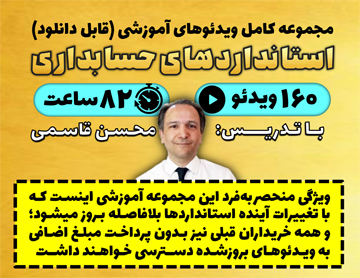تکنیکهای ارزشیابی: (استاندارد حسابداری 42 اندازهگیری ارزش منصفانه (مصوب 1399))
60. واحد تجاری باید از تکنیکهای ارزشیابی استفاده کند که متناسب با شرایط است و به منظور اندازهگیری ارزش منصفانه، برای آنها دادههای کافی در دسترس میباشد و استفاده از دادههای ورودی قابل مشاهده مربوط را حداكثر و استفاده از دادههای ورودی غیرقابل مشاهده را حداقل میکند.
61. هدف از استفاده از یک تکنیک ارزشیابی، برآورد قیمتی است که بر اساس آن، معاملهای نظاممند برای فروش دارایی یا انتقال بدهی بین فعالان بازار در تاریخ اندازهگیری در شرایط جاری بازار انجام میشود. سه تکنیک ارزشیابی که در سطح وسیع مورد استفاده قرار میگیرد، شامل تکنیک با رویكرد بازار، تکنیک با رویكرد بهای تمام شده و تکنیک با رویكرد درآمد است. جنبههای اصلی این رویكردها در بندهای ب5 تا ب11 بطور خلاصه ارائه میشود. یک واحد تجاری برای اندازهگیری ارزش منصفانه باید از تکنیکهای ارزشیابی سازگار با یك یا چند رویكرد از آن رویکردها استفاده نماید.
62. در برخی موارد، تنها یک تکنیک ارزشیابی مناسب است (مانند زمانی که دارایی یا بدهی، با استفاده از قیمتهای اعلامشده در بازاری فعال برای داراییها یا بدهیهای همانند، ارزشیابی میشود). در سایر موارد، چندین تکنیک ارزشیابی مناسب خواهد بود (مانند ارزشیابی یک واحد مولد نقد). چنانچه از چندین تکنیک ارزشیابی برای اندازهگیری ارزش منصفانه استفاده میشود، نتایج (یعنی شاخصهای مربوط به ارزش منصفانه) باید با توجه به معقول بودن دامنه ارزشهای مبتنی بر آن نتایج، ارزیابی شود. اندازهگیری ارزش منصفانه، نقطهای از آن دامنه است که بهترین معرف از ارزش منصفانه در آن شرایط باشد.
63. اگر قیمت معامله، ارزش منصفانه در شناخت اولیه باشد و برای اندازهگیری ارزش منصفانه در دورههای بعد، از یک تکنیک ارزشیابی استفاده شود که از دادههای ورودی غیرقابل مشاهده استفاده میکند، تکنیک ارزشیابی مذکور باید بهگونهای تنظیم شود که نتیجه آن در شناخت اولیه، با قیمت معامله برابر باشد. تنظیم تکنیک ارزشیابی اطمینان میدهد که تکنیک ارزشیابی شرایط جاری بازار را منعكس و به واحد تجاری در تعیین اینکه تعدیل تکنیک ارزشیابی ضرورت دارد یا خیر (برای مثال، ممکن است دارایی یا بدهی دارای یک ویژگی باشد که در تکنیک ارزشیابی مورد توجه قرار نگرفته است)، کمک میکند. پس از شناخت اولیه، هنگام اندازهگیری ارزش منصفانه با استفاده از تکنیک یا تکنیکهای ارزشیابی که از دادههای ورودی غیرقابل مشاهده استفاده میکنند، واحد تجاری باید اطمینان یابد که آن تکنیکهای ارزشیابی، دادههای ورودی قابل مشاهده در بازار (مانند قیمت دارایی یا بدهی مشابه) را در تاریخ اندازهگیری منعكس میكنند.
64. تکنیکهای ارزشیابی مورد استفاده برای اندازهگیری ارزش منصفانه باید با ثبات رویه بکار گرفته شود. با وجود این، تغییر در تکنیک ارزشیابی یا بکارگیری آن (برای مثال، تغییر در وزن آن تکنیک هنگام استفاده از چندین تکنیک ارزشیابی یا تغییر در تعدیل اعمالشده در تکنیک ارزشیابی)، هنگامی مناسب است که آن تغییر، منجر به مبلغی شود كه معرف بهتری از ارزش منصفانه یا معادل تکنیک قبلی معرف ارزش منصفانه در آن شرایط باشد. برای مثال، این مورد ممکن است در صورت وقوع هر یک از رویدادهای زیر مصداق داشته باشد:
- الف. ایجاد بازارهای جدید؛
- ب. در دسترس بودن اطلاعات جدید؛
- پ. در دسترس نبودن اطلاعات استفادهشده در گذشته؛
- ت. بهبود تکنیکهای ارزشیابی؛ یا
- ث. تغییر شرایط بازار.
65. تجدیدنظرهای ناشی از تغییر در یک تکنیک ارزشیابی یا بکارگیری آن، باید طبق استاندارد حسابداری 34 به عنوان تغییر در برآورد حسابداری محسوب شود. با وجود این، افشاهای مندرج در استاندارد حسابداری 34 درخصوص تغییر در برآورد حسابداری، بابت تجدیدنظرهای ناشی از تغییر در یک تکنیک ارزشیابی یا بکارگیری آن، الزامی نیست.
Valuation techniques: - IFRS 13 Fair Value Measurement
| 61 | An entity shall use valuation techniques that are appropriate in the circumstances and for which sufficient data are available to measure fair value, maximising the use of relevant observable inputs and minimising the use of unobservable inputs. |
62 | The objective of using a valuation technique is to estimate the price at which an orderly transaction to sell the asset or to transfer the liability would take place between market participants at the measurement date under current market conditions. Three widely used valuation techniques are the market approach, the cost approach and the income approach. The main aspects of those approaches are summarised in paragraphs B5–B11. An entity shall use valuation techniques consistent with one or more of those approaches to measure fair value. |
63 | In some cases a single valuation technique will be appropriate (eg when valuing an asset or a liability using quoted prices in an active market for identical assets or liabilities). In other cases, multiple valuation techniques will be appropriate (eg that might be the case when valuing a cash‑generating unit). If multiple valuation techniques are used to measure fair value, the results (ie respective indications of fair value) shall be evaluated considering the reasonableness of the range of values indicated by those results. A fair value measurement is the point within that range that is most representative of fair value in the circumstances. |
64 | If the transaction price is fair value at initial recognition and a valuation technique that uses unobservable inputs will be used to measure fair value in subsequent periods, the valuation technique shall be calibrated so that at initial recognition the result of the valuation technique equals the transaction price. Calibration ensures that the valuation technique reflects current market conditions, and it helps an entity to determine whether an adjustment to the valuation technique is necessary (eg there might be a characteristic of the asset or liability that is not captured by the valuation technique). After initial recognition, when measuring fair value using a valuation technique or techniques that use unobservable inputs, an entity shall ensure that those valuation techniques reflect observable market data (eg the price for a similar asset or liability) at the measurement date. |
65 | Valuation techniques used to measure fair value shall be applied consistently. However, a change in a valuation technique or its application (eg a change in its weighting when multiple valuation techniques are used or a change in an adjustment applied to a valuation technique) is appropriate if the change results in a measurement that is equally or more representative of fair value in the circumstances. That might be the case if, for example, any of the following events take place:
|
66 | Revisions resulting from a change in the valuation technique or its application shall be accounted for as a change in accounting estimate in accordance with IAS 8. However, the disclosures in IAS 8 for a change in accounting estimate are not required for revisions resulting from a change in a valuation technique or its application. |






دیدگاه خود را بنویسید